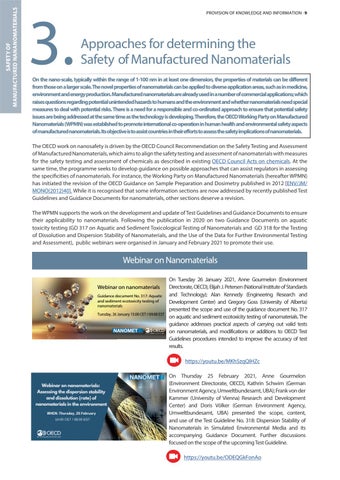SAFETY OF MANUFACTURED NANANOMATERIALS
3.
PROVISION OF KNOWLEDGE AND INFORMATION . 9
Approaches for determining the Safety of Manufactured Nanomaterials BOX 4: INVESTMENTS IN WATER SUPPLY AND SANITATION HAVE NOT KEPT PACE WITH AMBITIONS
On the nano-scale, typically within the range of 1-100 nm in at least one dimension, the properties of materials can be different from those on a larger scale. The novel properties of nanomaterials can be applied to diverse application areas, such as in medicine, environment and energy production. Manufactured nanomaterials are already used in a number of commercial applications; which raises questions regarding potential unintended hazards to humans and the environment and whether nanomaterials need special measures to deal with potential risks. There is a need for a responsible and co-ordinated approach to ensure that potential safety issues are being addressed at the same time as the technology is developing. Therefore, the OECD Working Party on Manufactured Nanomaterials (WPMN) was established to promote international co-operation in human health and environmental safety aspects of manufactured nanomaterials. Its objective is to assist countries in their efforts to assess the safety implications of nanomaterials. The OECD work on nanosafety is driven by the OECD Council Recommendation on the Safety Testing and Assessment of Manufactured Nanomaterials, which aims to align the safety testing and assessment of nanomaterials with measures for the safety testing and assessment of chemicals as described in existing OECD Council Acts on chemicals. At the same time, the programme seeks to develop guidance on possible approaches that can assist regulators in assessing the specificities of nanomaterials. For instance, the Working Party on Manufactured Nanomaterials (hereafter WPMN) has initiated the revision of the OECD Guidance on Sample Preparation and Dosimetry published in 2012 [ENV/JM/ MONO(2012)40]. While it is recognised that some information sections are now addressed by recently published Test Guidelines and Guidance Documents for nanomaterials, other sections deserve a revision. The WPMN supports the work on the development and update of Test Guidelines and Guidance Documents to ensure their applicability to nanomaterials. Following the publication in 2020 on two Guidance Documents on aquatic toxicity testing (GD 317 on Aquatic and Sediment Toxicological Testing of Nanomaterials and GD 318 for the Testing of Dissolution and Dispersion Stability of Nanomaterials, and the Use of the Data for Further Environmental Testing and Assessment), public webinars were organised in January and February 2021 to promote their use.
Webinar on Nanomaterials Webinar on nanomaterials Guidance document No. 317: Aquatic and sediment ecotoxicity testing of nanomaterials Tuesday, 26 January 15:00 CET / 09:00 EST
NANOMET
On Tuesday 26 January 2021, Anne Gourmelon (Environment Directorate, OECD), Elijah J. Petersen (National Institute of Standards and Technology); Alan Kennedy (Engineering Research and Development Center) and Gregory Goss (University of Alberta) presented the scope and use of the guidance document No. 317 on aquatic and sediment ecotoxicity testing of nanomaterials. The guidance addresses practical aspects of carrying out valid tests on nanomaterials, and modifications or additions to OECD Test Guidelines procedures intended to improve the accuracy of test results. https://youtu.be/MKhSzqQIHZc On Thursday 25 February 2021, Anne Gourmelon (Environment Directorate, OECD), Kathrin Schwirn (German Environment Agency, Umweltbundesamt, UBA); Frank von der Kammer (University of Vienna) Research and Development Center) and Doris Völker (German Environment Agency, Umweltbundesamt, UBA) presented the scope, content, and use of the Test Guideline No. 318: Dispersion Stability of Nanomaterials in Simulated Environmental Media and its accompanying Guidance Document. Further discussions focused on the scope of the upcoming Test Guideline. https://youtu.be/ODEQGkFonAo










